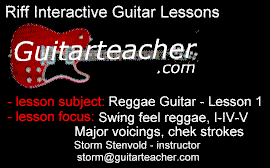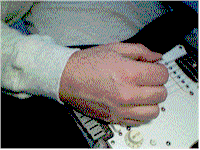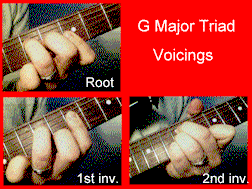Scroll through the lesson and click on notation/video/audio links to load the interactive players.
| Storm Stenvold >> Reggae and Ska >> |
|
|
Please subscribe to get full access to all lessons for only $7.95/month PLUS 1 week free trial.

Riff Interactive lessons are
LESS expensive and
MORE interactive than alternatives!
More Info
|
|
Lesson
Subject

Lesson Sample
Lesson Jam Track
(Key of G)
Teacher: hi guys. Reggae style guitar for the
rest of the month.
Teacher: Go ahead and load up the lesson sample
and the looping track.
henry: got it
dh: hi, sounds interesting that is why I am
here
Teacher: Cool. We will look at a variety of
typical reggae grooves with accompaning techniques and riffs over the next few
weeks. Starting off tonight with a old school, classic Reggae shuffle/swing
groove
Chek
Stroke over G-C-D
Teacher: The chord progression is G - C, G - C -
D.
Teacher: This progression, a I - IV - V, lies at
the heart of many famous Reggae tunes. Bob Marley's 'One Love' and 'Stir It Up'
come to mind.
Teacher: The feel tonight is over a 'One Drop'
groove. Here the drummer place a rimshot on beat 3 with the guitar handling the
typical backbeat position of beats 2 and
4.
G-C-D Chord
Progression
Teacher: The pattern is deceptively simple, but
their are a few points up front to discuss when trying achieve a good Reggae
sound.
Teacher: First is the coordination of the two
hands. Of particular importance is the 'choke' in the left hand. The sound of
the chords is very staccato, or short, as a rule.
Left Hand
choke
Teacher: To get the sound, release the pressure
from the fingers without removing them from the strings. Here is a close up
video of the left hand.
Frank: Is it typical in Regae to play chords all the way
up the neck instead of "in the box"?
Teacher: I will give some other ways to play
tonight's progression.
Teacher: Typical you want to stay in the middle
of the neck, between frets 5 and 12. And on the top 3 or 4
strings.
Frank:
Ah, I see.
gretschroundup: yes, good video - I'm with
you...
Teacher: In the right hand, a slight palm mute
will be helpful to control any unwanted ringing
Palm
Muting

Right Hand
Teacher:
cool.
Teacher: lay the outside of the palm lightly
where the strings come off the bridge. Experiment with position and pressure so
that you may create a very dry sound but still hear the notes of the
chord
Teacher: Here are some other voicings of the G
major chord that will be useful.
G Triad Voicings
Major Chord
Voicings

kozz: yo
Teacher: yo kozz. Welcome, reggae style
lesson.
Frank:
Which pickup(s) are you using on your Strat, and what guage
strings?
Teacher: Placing the notes of the chord in a
different order gives you an inversion. These will be useful to move through the
progression without having to jump around on the neck.
Teacher: Middle pickup of a typical Strat. Your
tone should be fairly dry, almost percussive. We will experiment with efffect
later but this will be a good place to
start.
Teacher: And different tones, too. Typical clean
sound for this lesson.
I-IV-V Voicing Pairs(G-C-D)
Teacher: one second, i have to drop out, don't go
anywhere
I-IV-V
Voicing Pairs(G-C-D)
Teacher:
hey
Teacher: some nice sets of voicings are shown.
Keeping your hand with a 4-5 fret range.
Teacher: This basic rhythm stroke we are playing
is called the 'chek' stroke. Think of this name when sounding chords on beats 2
and 4.
Teacher: We can add an answering stroke on the
upbeat, giving us the 'chek-a' stroke.
Chek-a Stroke
Chek-a
Stroke
Teacher:
This is almost always a downstroke-upstroke combination. Try with 2 downstrokes.
One of the misunderstood parts of Reggae is that because it is played on
off-beats that one uses upstrokes. Downstrokes provide a more powerful, support
sound.
Teacher: Still, use down-up for the 'chek-a'
stroke for the most part.
Teacher: To add a further percussive dimension to
your parts we can add rhythm scratches between strokes.
John:
Are we live now?
Scratch + Chord Variations
Support:
yes, this is live John
Teacher: or is it The
Matrix?
Teacher: anyone on their laptop in line for that
movie right now?
Rhythm Scratches
John: My WI FI
doesn't work that far away from base....nor is my guitar cord that
long....LOL
Teacher: Tonights progression is right from the
key of G Major. In a major key, their are three main approaches to adding single
note leads and supporting parts.
Teacher: Mine either.
Teacher: First you might want to check out notes
straight from the chords. Arpeggios.
Frank: the scratch is cool...so simple its almost hard!
HA HA
G-C-D
Arpeggios
Teacher:
You might come up with a counter line to the rhythm guitar or the melody. Again,
palm muting is often used for these 'stuckey' lines.
Counter-Line (Stuckey Part)
Teacher:
Many basslines use arpeggios. It is always good to know the bassline so you can
double the bass part. A typical and important sound.
Bassline
bart: Is
'stuckey' a word you made up?
Teacher: I heard it first used by the other
guitarist I learned from in my first Reggae band. We reworked R&B tunes
Reggae-style. I have seen it used other places, as well
Teacher: I like it because the sound sounds like
the name
Frank:
Regae originated in the West Indies, right? I head a Regae band in the Bahamas,
complete with a steel drum. They were
great.
bart: I
thought Jamaica
Teacher: Right. Jamaica, specifically. Reworked
American R&B with African and Caribbean/Latin rhythms. I didn't have time to
run down a full background but will do so bit by bit.
Teacher: The major scale is important to know to
fill around the chords and for its melodic potential.
G Major
Scale
Major Scale
Line
Teacher:
The major scale line uses an "against-the-grain" sound of using straight 8th
notes over a shuffle groove. This can work the other way around as
well.
Teacher: And the Major Pentatonic scale is a
great, smooth sounding choice
G Major Pentatonic
Teacher:
Here a couple of useful patterns and a
lick
Major
Pentatonic - Diagonal Pattern
Major Pentatonic
Lick
elrod: that
major pent lick with the pull-off, is there audio for
that?
Teacher: That's it for tonight's lesson. I hope
to see you back here next week. Catch up with me at my website,
www.guitarteacher.com or on the Riff Interactive message board for any
questions
Frank:
Storm, what does the "H" mean in the
pattern?
Teacher: Hammeron
Teacher: click the speaker icon, then click it
again to play back after the audio
loads.
John:
Thanks Storm. First lesson, but really enjoyed it.
Teacher: got to go. Have a great week. Your
welcome.
|
<< load notation from left
|
|
<< load audio from left
|
<< load audio from left
|